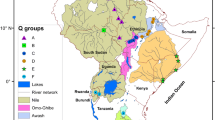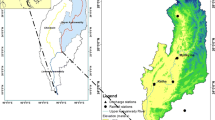Abstract
The effect of climate change on water resources is an important challenge. To analyze the negative effects of this phenomenon and recommend adaptive measures, it is necessary to assess streamflow simulation scenarios and streamflow transition probabilities in future periods. This paper employs the HadCM3 (Hadley Centre Coupled Model, version 3) model to generate climate change scenarios in future periods (2010–2039, 2040–2069, and 2070–2099) and under A2 emission scenarios. By introducing climatic variable time series in future periods to the IHACRES (Identification of unit Hydrographs And Component flows from Rainfall, Evaporation and Streamflow data) hydrological model, long-term streamflow simulation scenarios are produced. By fitting statistically different distributions on runoff produced by using goodness-of-fit tests, the most appropriate statistical distribution for each month is chosen and relevant statistical parameters are extracted and compared with statistical parameters of runoff in the base period. Results show that long-term annual runoff average in the three future periods compared to the period 2000–1971 will decrease 22, 11, and 65 %, respectively. ِDespite the reduction in total runoff volume in future periods compared to the baseline period, the decrease is related to medium and high flows. In low flows, total runoff volumes for future periods compared to the baseline period will increase 47, 41, and 14 %, respectively. To further assess the impact of annual average runoff on flows, it is necessary to examine the correlation of time series using streamflow transition probabilities. To compare the streamflow transition probability in each of the future periods with base period streamflow in each month, streamflow is discretized and performance criteria are used. Results show a low coefficient of correlation and high error indicators.







Similar content being viewed by others
References
Acharya A, Piechota TC, Tootle G (2011) Quantitative assessment of climate change on the hydrology of the north Platte river watershed, Wyoming. J Hydrol Eng. doi:10.1061/(ASCE)HE.1943-5584.0000543
Ashofteh PS, Bozorg Haddad O, Mariño MA (2012) Climate change impact on reservoir performance indices in agricultural water supply. J Irrig Drain Eng. doi:10.1061/(ASCE)IR.1943-4774.0000496
Diaz-Nieto J, Wilby RL (2005) A comparison of statistical and climate change factor methods: impacts on low flows in the river Thames, United Kingdom. Clim Chang 69(2–3):245–268
Ekström M, Hingray B, Mezghani A, Jones PD (2005) Regional climate model data used within the SWURVE project 2: addressing uncertainty in regional climate model data for five European case study areas. Hydrol Earth Syst Sci 11(1):1085–1096
Feng X, Zhang G, Yin X (2011) Hydrological responses to climate change in Nenjiang River Basin, Northeastern China. Water Resour Manag 25(2):677–689
Harma KJ, Johnson MS, Cohen SJ (2012) Future water supply and demand in the Okanagan Basin, British Columbia: a scenario-based analysis of multiple, interacting stressors. Water Resour Manag 26(3):667–689
Hu TS, Lam KC, Ng ST (2001) River flow time series prediction with a range dependent neural network. Hydrol Sci J 46(5):729–745
IPCC (2008) Climate change and water. Cambridge University Press, Cambridge
IPCC-TGCIA (1999) Guidelines on the use of scenario data for climate impact and adaptation assessment. Version 1. In: Carter TR, Hulme M, Lal M (Eds) Intergovernmental panel on climate change, task group on scenarios for climate impact assessment, p 69
Jakeman AJ, Hornberger GM (1993) How much complexity is warranted in a rainfall-runoff model? Water Resour Res 29(8):2637–2649
Kite GW (1977) Frequency and risk analysis in hydrology. Water Resources Publications, Fort Collins, p 224
Lin JY, Cheng CT, Chau KW (2006) Using support vector machines for long-term discharge prediction. Hydrol Sci J 51(4):599–612
Littlewood IG, Down K, Parker JR and Post DA (1997) IHACRES: Catchment-scale rainfall streamflow modelling (PC version) Version 1.0—April 1997. Institute of Hydrology, Centre for Ecology and Hydrology, Wallingford, Oxon. http://www.nwl.ac.uk/ih/www/products/mswihacres.html
Liuzzo L, Noto LV, Vivoni ER, Loggia G (2010) Basin-scale water resources assessment in Oklahoma under systematic climate change scenarios using a fully distributed hydrologic model. J Hydrol Eng 15(2):107–118
Moriasi DN et al (2007) Model evaluation guidelines for systematic quantification of accuracy in watershed simulations. Trans ASABE 50(3):885–900
Shokri A, Bozorg Haddad O, Mariño MA (2012) Reservoir operation for simultaneously meeting water demand and sediment flushing: a stochastic dynamic programming approach with two uncertainties. J Water Res Plan Manag. doi:10.1061/(ASCE)WR.1943-5452.0000244
Traynham L, Palmer R, Polebitski A (2011) Impacts of future climate conditions and forecasted population growth on water supply systems in the puget sound region. J Water Resour Plan Manag 137(4):318–326
Wilby RL, Harris I (2006) A framework for assessing uncertainties in climate change impacts: low-flow scenarios for the River Thames, UK. Water Resour Res 42:W02419
Yu PS, Yang TC, Wu CK (2002) Impact of climate change on water resources in southern Taiwan. J Hydrol 260(1–4):161–175
Zhang JY, Wang GQ, He RM, Liu CS (2009) Variation trends of runoffs in the Middle Yellow River basin and its response to climate change. Adv Water Sci 20(2):153–158
Author information
Authors and Affiliations
Corresponding author
Rights and permissions
About this article
Cite this article
Ashofteh, P.S., Bozorg Haddad, O. & Mariño, M.A. Scenario Assessment of Streamflow Simulation and its Transition Probability in Future Periods Under Climate Change. Water Resour Manage 27, 255–274 (2013). https://doi.org/10.1007/s11269-012-0182-2
Received:
Accepted:
Published:
Issue Date:
DOI: https://doi.org/10.1007/s11269-012-0182-2




